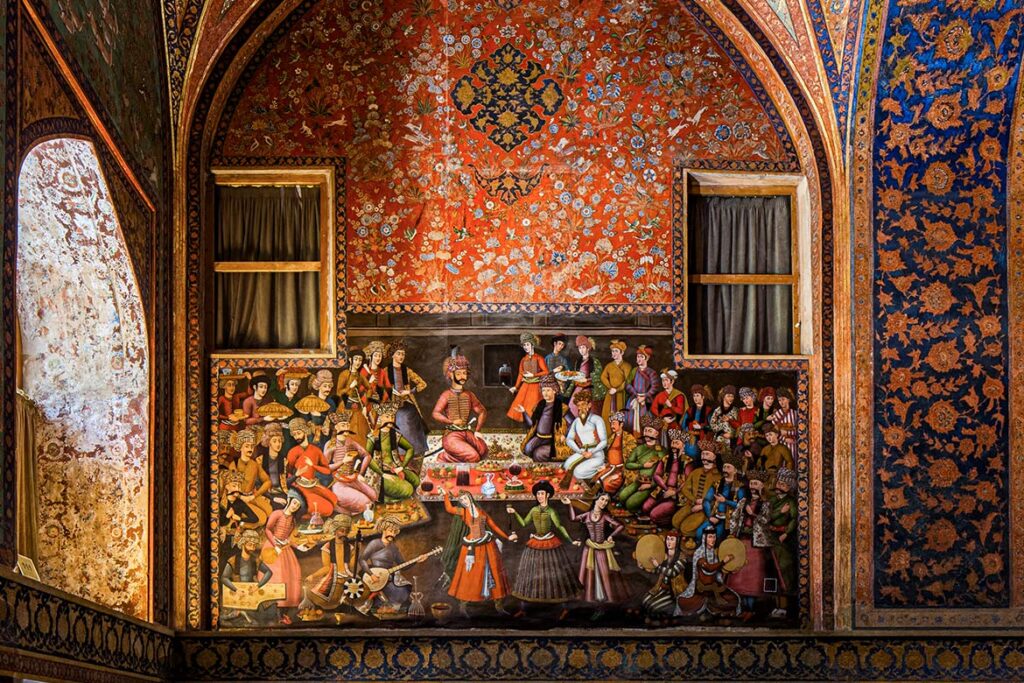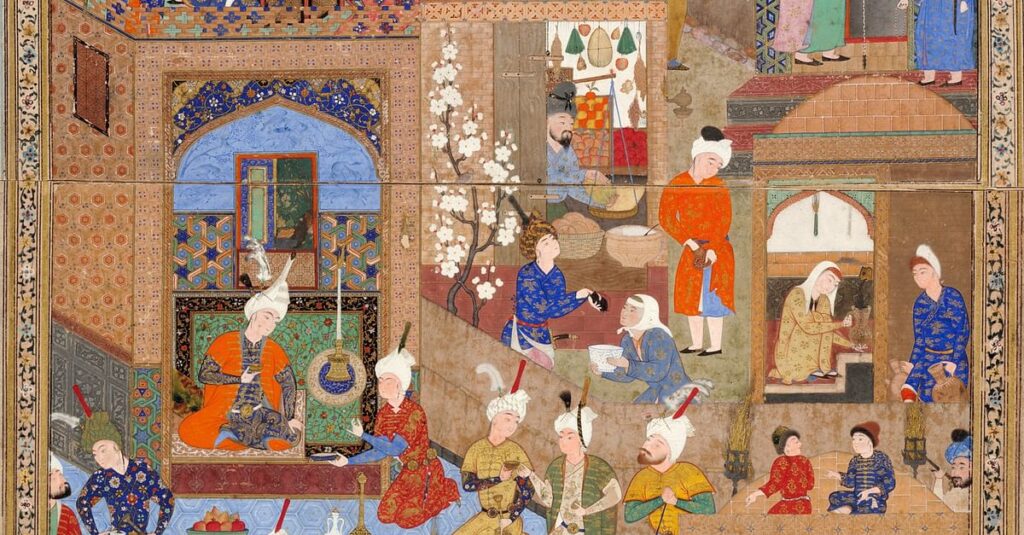Handicraft
Persian art or Iranian art has one of the richest art heritages in world history and has been strong in many media including architecture, painting, weaving, pottery, calligraphy, metalworking and sculpture. At different times, influences from the art of neighbouring civilizations have been very important, and latterly Persian art gave and received major influences as part of the wider styles of Islamic art. This article covers the art of Persia up to 1925, and the end of the Qajar dynasty; for later art see Iranian modern and contemporary art, and for traditional crafts see arts of Iran. Rock art in Iran is its most ancient surviving art. Iranian architecture is covered at that article.
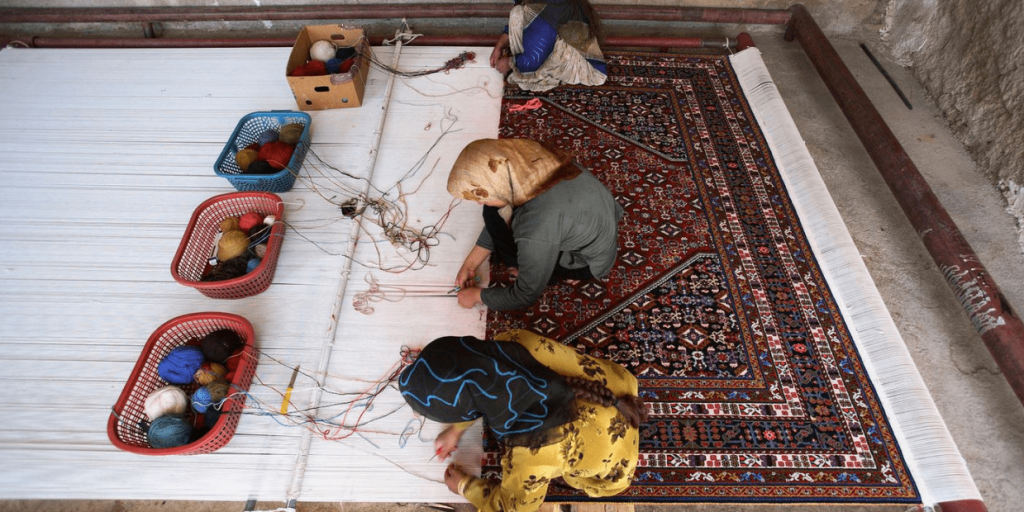
Persian art is best known in the West for its carpets. Europeans had their first encounter with Persian rugs by at least the 15th century and the initial impression has never changed; in carpet weaving Iran is considered to have no equal. No researcher can define the exact beginning date of carpet weaving in Iran. The earliest-known Iranian carpet, now named Pazyrik after the archaeological site in Siberia where it was exhumed from the frozen tombs of Scythian chiefs, dates from about 500 B.C.
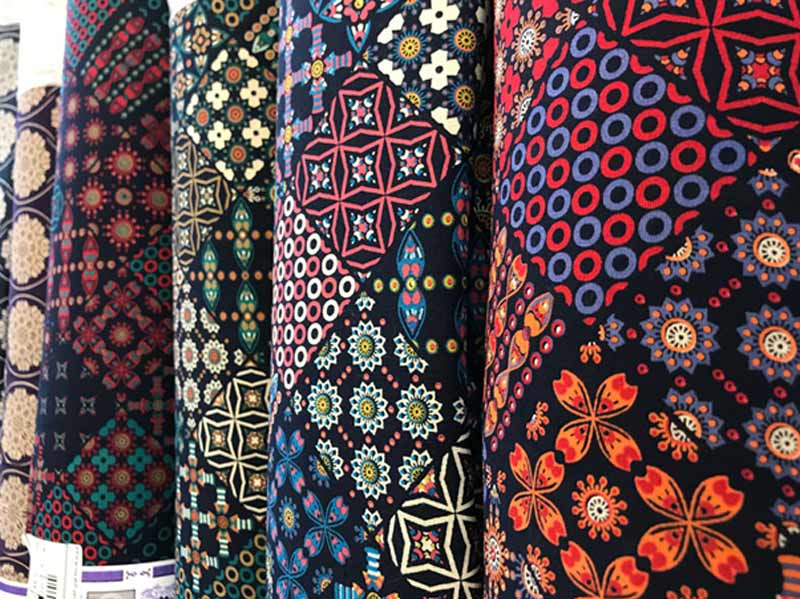
Enamel | Mina kari
Enamel or Minakari, “This dazzling art of earth and fire…saturated but lucent colours thrives today in Isfahan. When minakari artists say they do not know when their art began here, they mean they are not sure when in the Safavid period – yet enamel onterracotta was known at Susa 1500 B.C., on metal was fully developed in the Oxus treasure of the sixth to fourth centuries B.C and after 500 B.C . “it was probably more elaborated in Persian than anywhere else.” Minakari today refers only to that enamel painted flat on a Metal base, usually copper, and covering it completely.
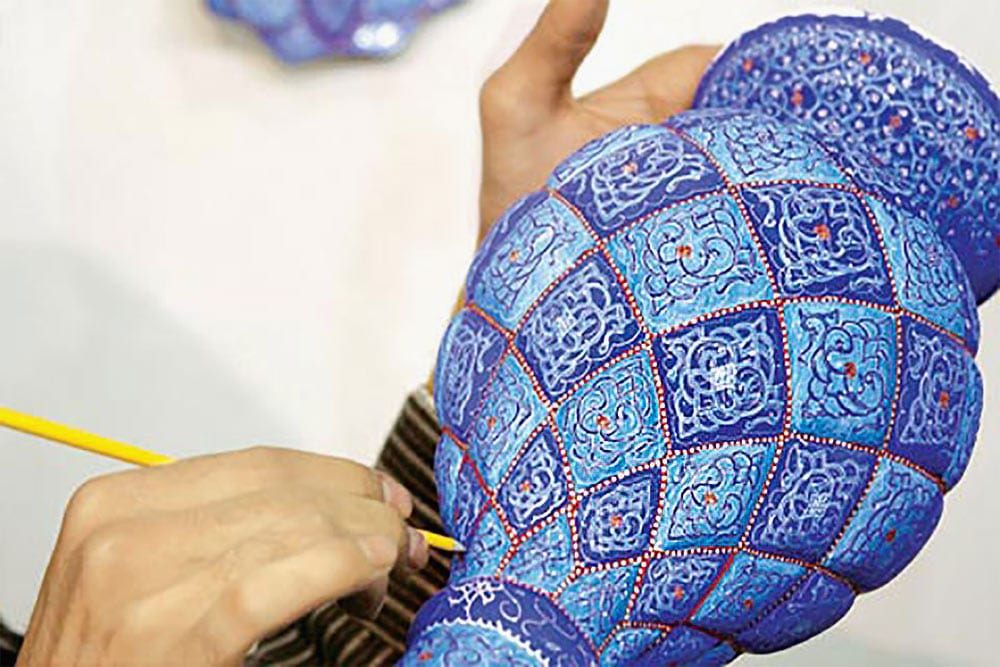
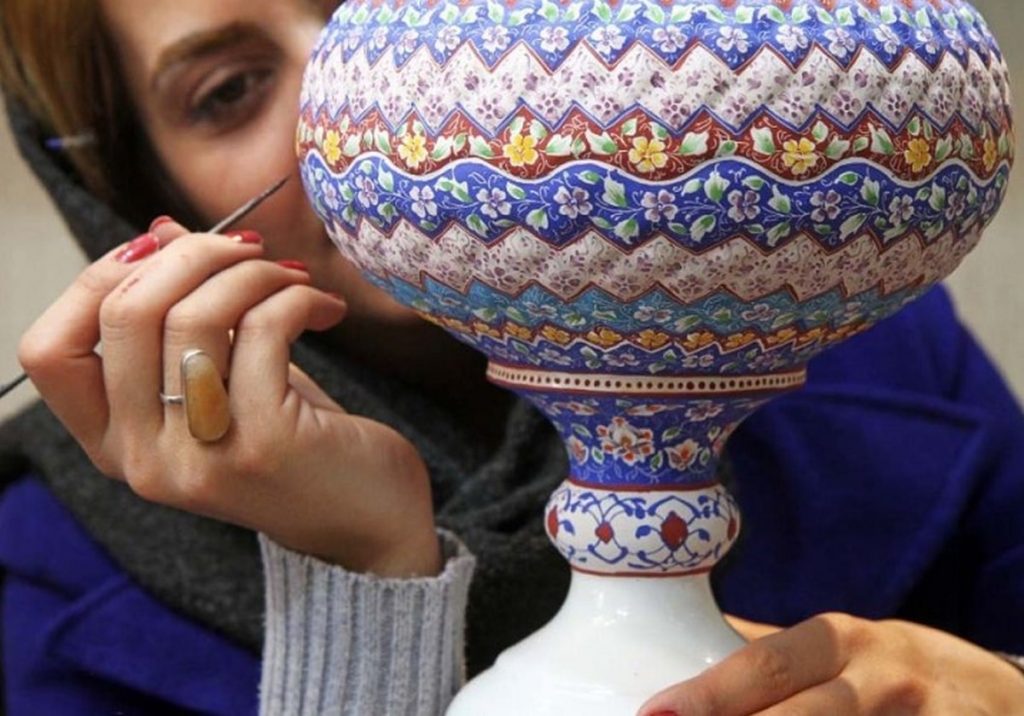
Ghalamzani (Engraving)
Ghalamzani is the art of carving superb designs on metals such as copper, brass, silver, and gold. The same as other Iranian arts, Isfahan is the main center for engraving with significant development in the Safavid dynasty.
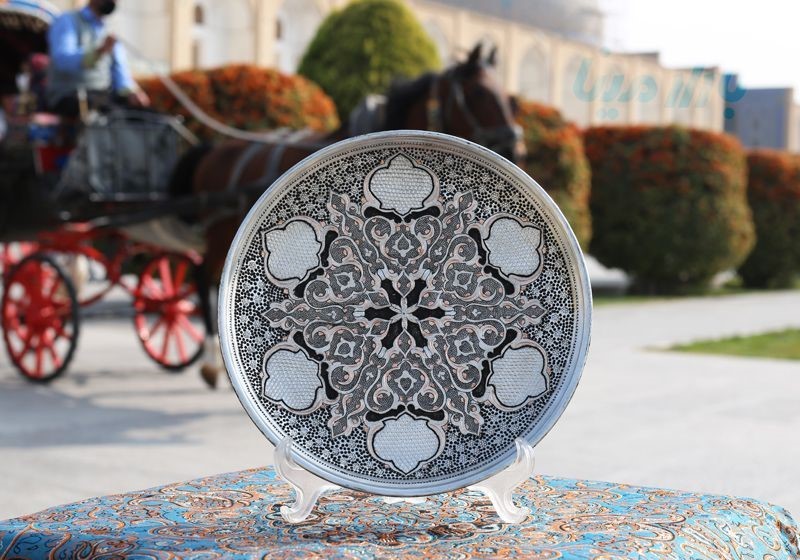
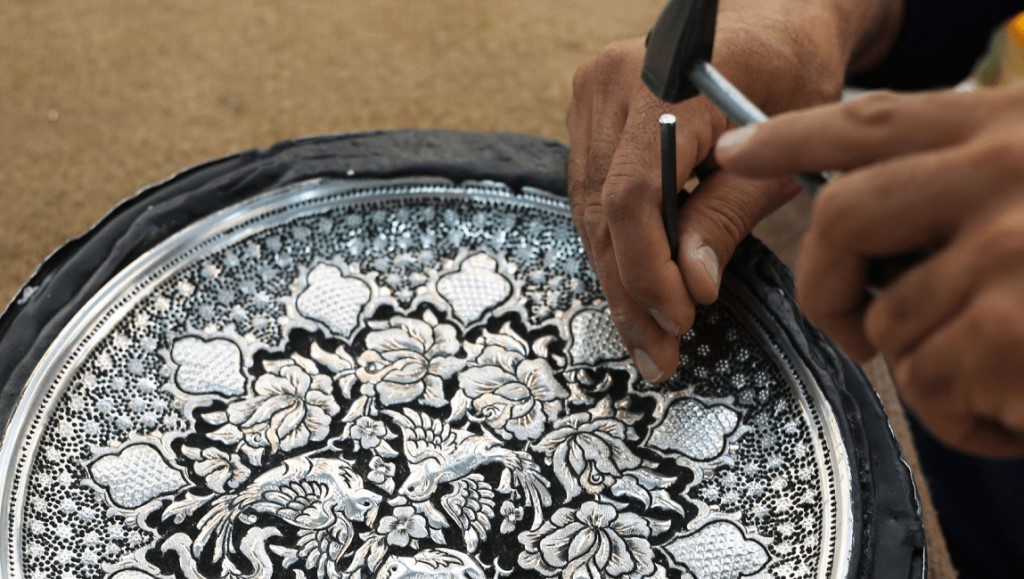
Firoozeh Koubi: Turquoise Stone Inlaying
Among the most exquisite handicrafts of Iran, Firooze Koubi is a very popular one. This Iranian handicraft is one of the Iran souvenirs produced by a large number of Persian handicraft suppliers. In turquoise inlaying art, small pieces of turquoise are set in mosaic fashion on the surface of various metals (coppers, brass, silver, and gold) to give the object a special glamor. Not only decorative dishes and utensils but also elegant accessories, including necklaces, rings, earrings, etc., can be ornamented by the small pieces of this precious gemstone. Turquoise stone inlaid dishes are among the most cost-effective handicraft in Iran, and many foreigners purchase them during their Iran shopping.
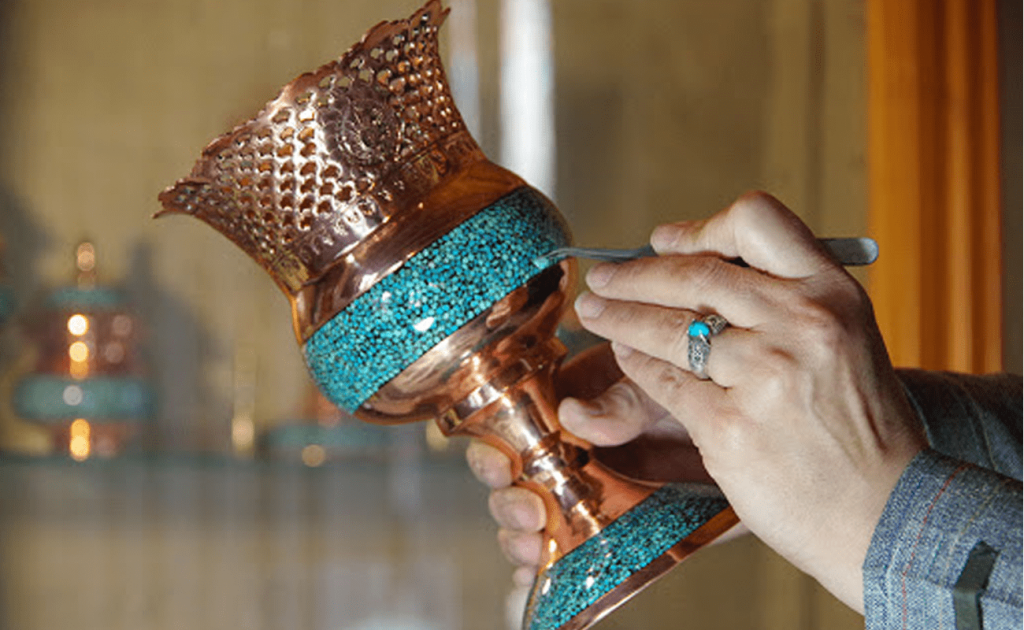

Khatamkari
Khatamkari is one of Persian handicrafts (Iranian handicrafts). Khatamkari is the art of decorating wooden objects using small triangles.
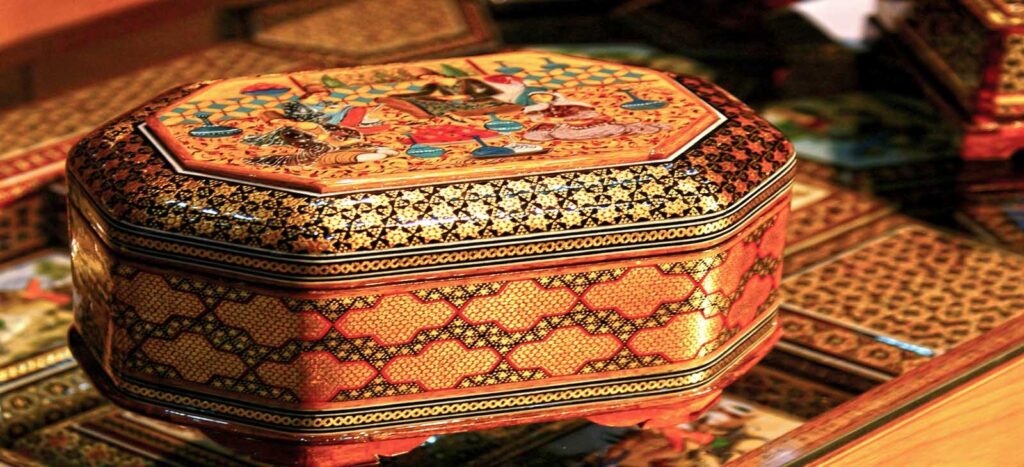
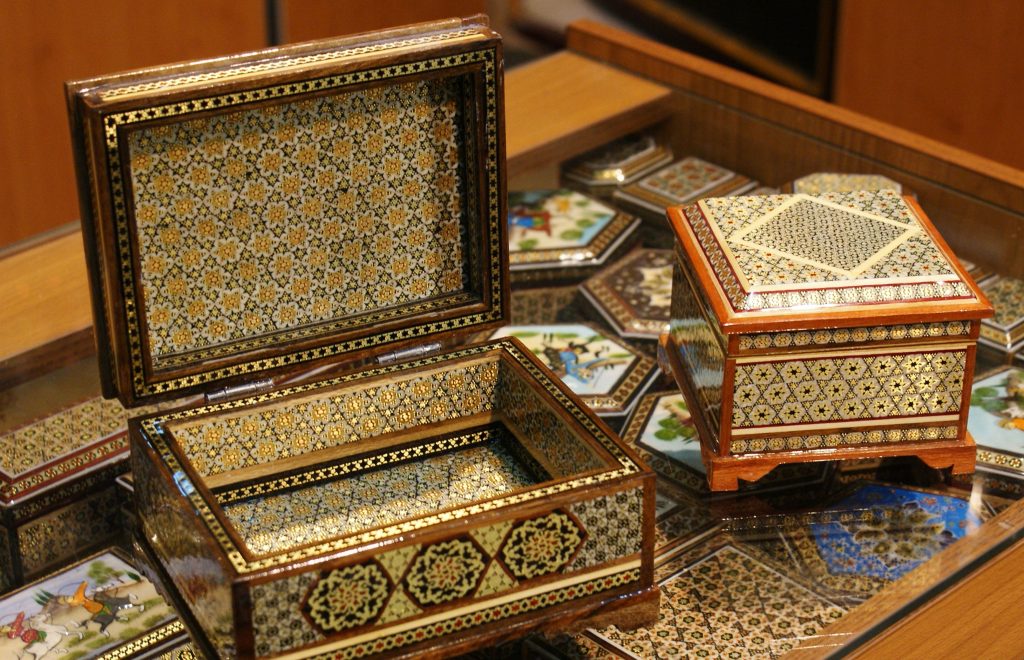
Termeh Weaving
Termeh, a handicraft made with high-quality threads, is a hand-woven colorful textile with special patterns, mainly paisley which was originated in Yazd. Termeh handicraft is a soft and elegant cloth which is made of various threads material, including silk, wool, and fluff. Termeh industry was very prosperous because of its popularity and different usages by the upper class of society until factory-made clothes and textiles were imported into the markets. Weaving Termeh handicraft is a careful and time-consuming work. Dating back to the beginning of the Safavid era, Termeh weaving is an old handicraft in Iran.
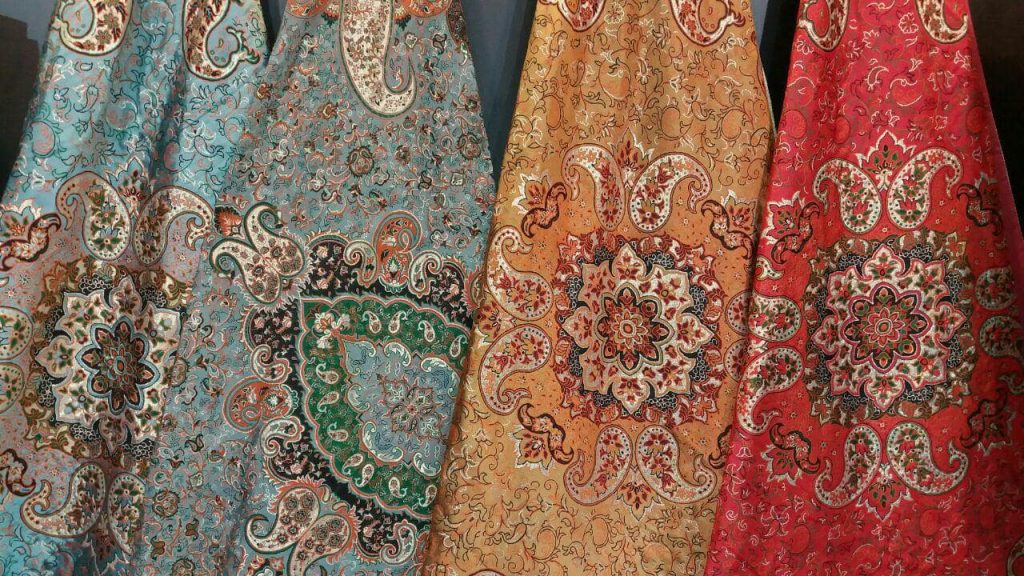
Monabat Kari ( Wood Carving art )
Monabat Kari is a branch of wood industry that is considered an artistic technique. It involves carving on wood and a woodcarver is someone who does the carving on the wood. This is a Persian Handicraft dating back to a time where humans acquainted with sharp tools and started to cut wood. In Iran, it has a long history and is a reminder of the past. It can be argued that the Iranian wood carving art history goes back to the first time Iranian got to know wood, making the history of wood inseparable from the history of Monabat Kari, therefore, wood carving has come a long way in reaching the present state. Currently, this art is a prevalent activity all over Iran with cities like Golpayegan, Esfahan, Shiraz, Abade, Malayer, Shahrod, etc, being the leaders.
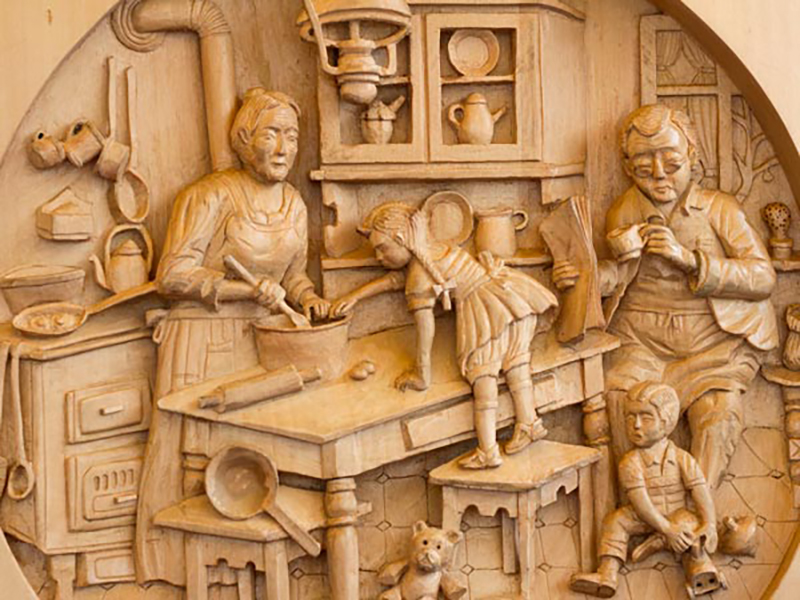
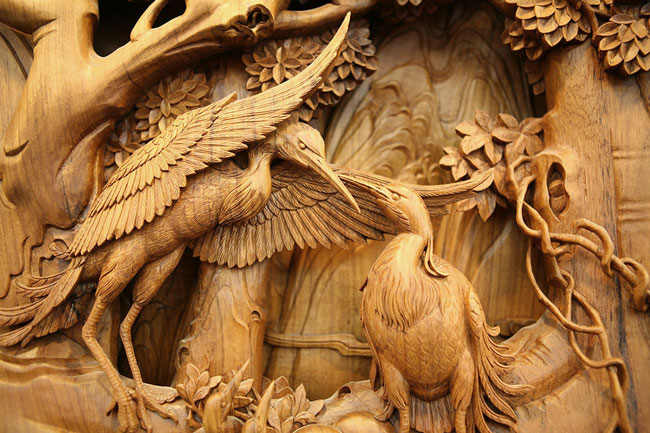
Moaragh Kari (Wood Inlaid Working)
Wood Inlaid (Moaragh) is the art of substitution of the different parts of a design by colored pieces of wood and integrating them with each other in order to decorate the surface of a tableau or other wooden understructures. Although the beginning of the emergence of this art is unknown, but it seems that India is the main birthplace of this art. The origin of wood inlaid working in Iran has stemmed from the art of inlaid working on tile which has emerged in the late Ilkhani Period and after Timurid Period. Lexically Inlaid (Moaragh) means a set comprised of tiny pieces joined together to form a mechanism. In wood inlaid working, according to the delicacy and complication of the design, different pieces of wood with a high variety of colors and also shell, bone and metal are used in order to improve the quality of the manifestation of the work.
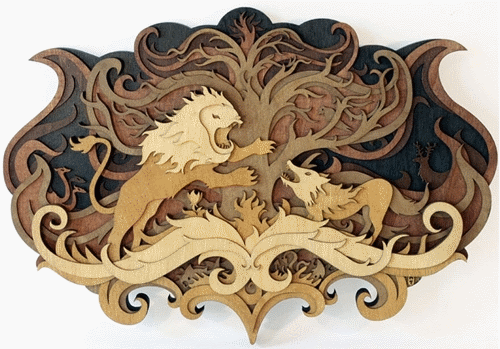
Pottery: Baked-Clay Forming
The history of the art of pottery in Iran goes back to ancient times around 4000 B.C. when agriculture came into existence and cultivation started on Iran plateau by primitive races of this land, and people made utensils of baked clay to meet their needs. Before glass manufacturing became widespread, most dishes used by humans, such as pitchers and bowls were pottery. Nowadays, pottery has turned into one of the most popular traditional handicrafts of Iran. The best performing soil for this Persian handicraft is clay, which is of a large amount of Iron red. Hundreds of Persian handicraft suppliers in Lalejin (Hamedan) and Meybod (Yazd) are producing exquisite colorful potteries.
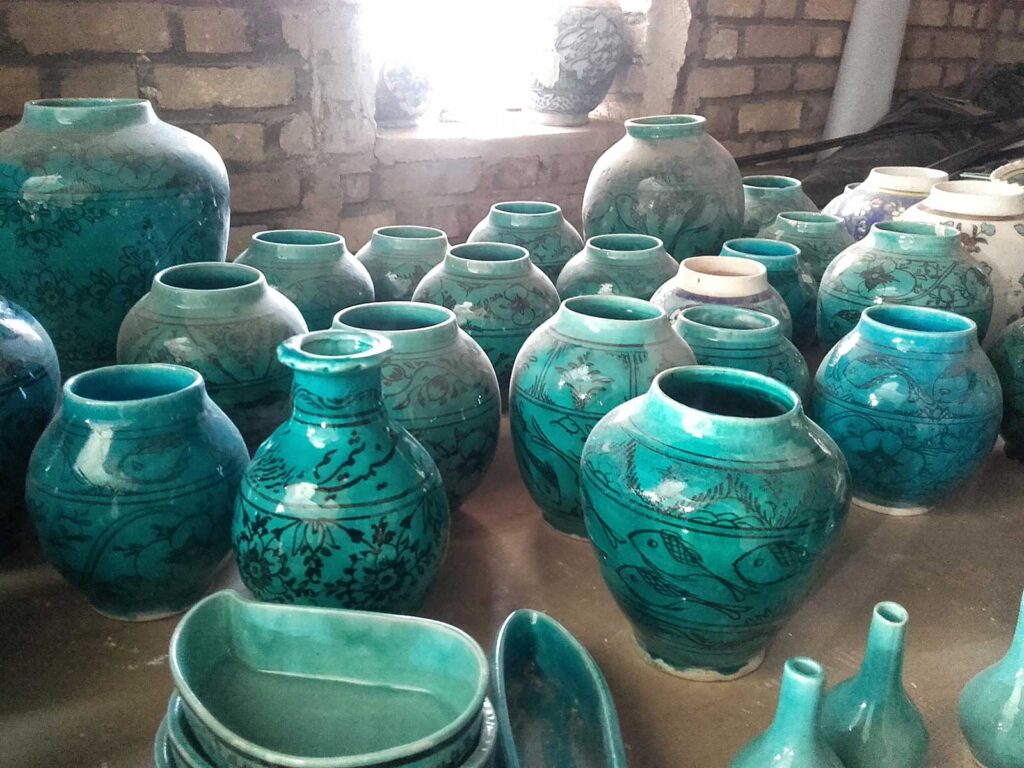
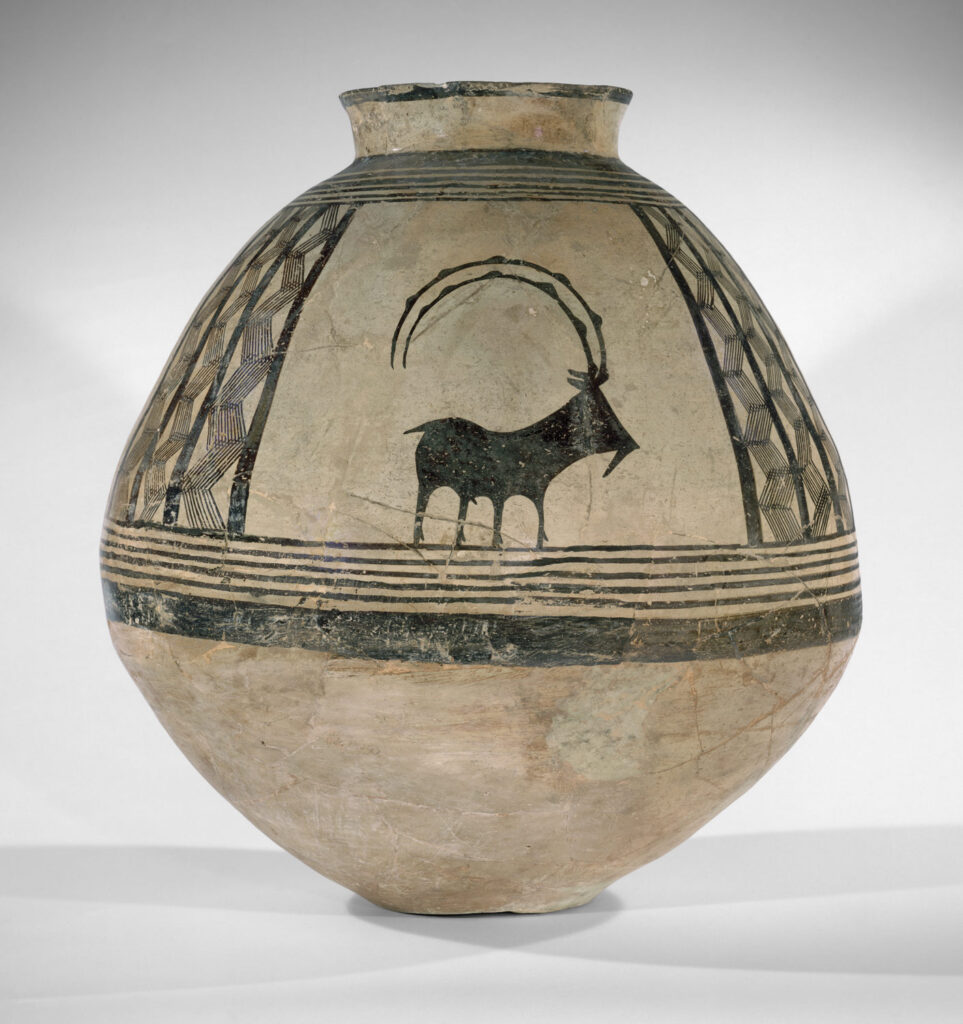
Giveh
Handmade Traditional Persian Klash shoes Of Marivan also called Giveh is traditional footwear that used to be very popular all over Iran in the past. The lightweight and breathable footwear were originally intended to be worn by men. However, in some regions, handmade shoes are welcomed by women too in the hot summertime.
Giveh is a kind of summer slippers, light, durable and suitable for long marches, with a long history especially for rural men and including handicrafts of Chaharmahal and Bakhtiari provinces, Kurdistan, Kermanshah, Ilam, Fars, Hamadan, Qazvin, Zanjan and In Kurdish regions such as Ilam, Kermanshah, Kurdistan, and West Azerbaijan, it is known as Kalash. All stages of the production of this clog are manual, and it is generally made of carpet thread, silk thread, and the sole is made of fabric, leather, or rubber. “Giveh” should be considered one of the most interesting and valuable handicrafts in rural Iran. Due to the fact that there are no rich sources about the origin of mercury, it is not possible to provide a document on this matter. But it is clear that since the beginning of human existence, man has been trying to find a way to not hurt his feet in order to meet his needs in nature. One of the characteristics of givah is to create symmetry, which means that there is a left and right leg for it, and each lenge can be worn for either leg. Walking with shoes fits the shape and morphology of the feet from the chest to the soles of the feet. This form relieves fatigue and pain in the legs while walking. Another important thing is that from the point of view of the environment, Giva does not cause any environmental pollution during its production and even after many years, because its consumables are completely natural. Its materials decompose in less than a year and return to their natural elements.
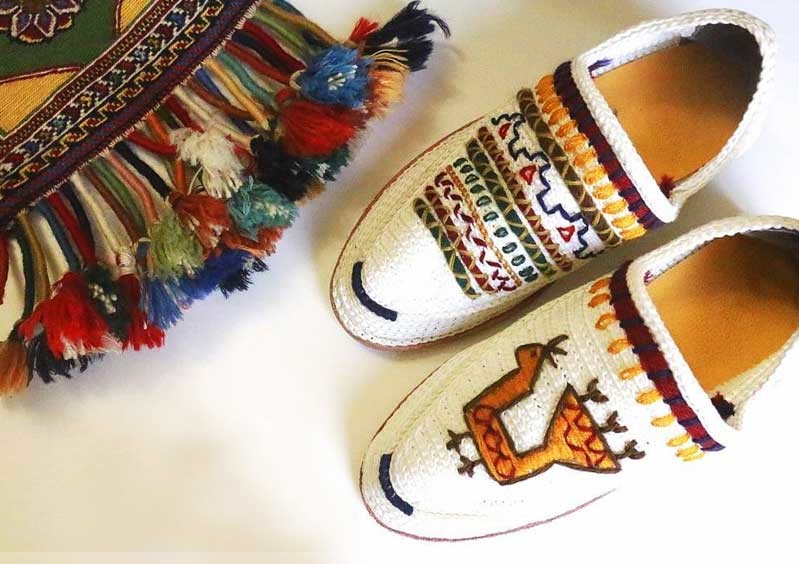
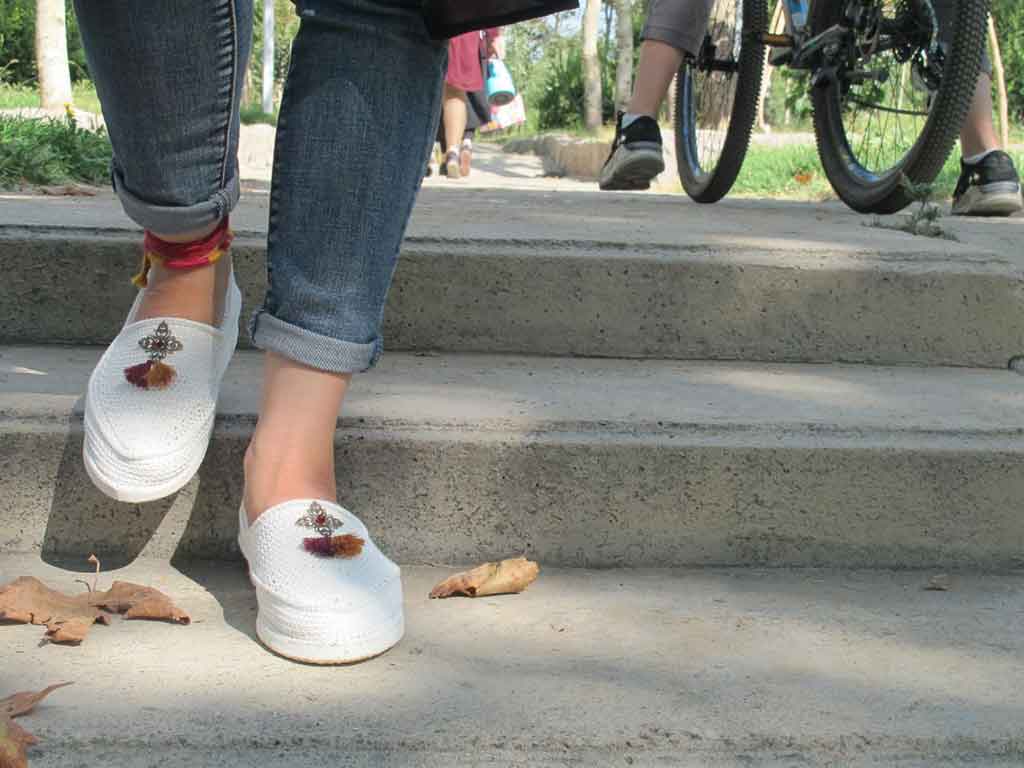
KELIM (GELIM)
a kind of flat-woven carpet employed by settled and nomadic families for a host of uses, primarily but not exclusively for covering household items and furnishing the interior of dwellings. Gelim is a term used in Persian-speaking parts of West Asia, especially in Iran, for large tapestry-woven textiles, also referred to as kilim in the Turkish speaking parts of West Asia.
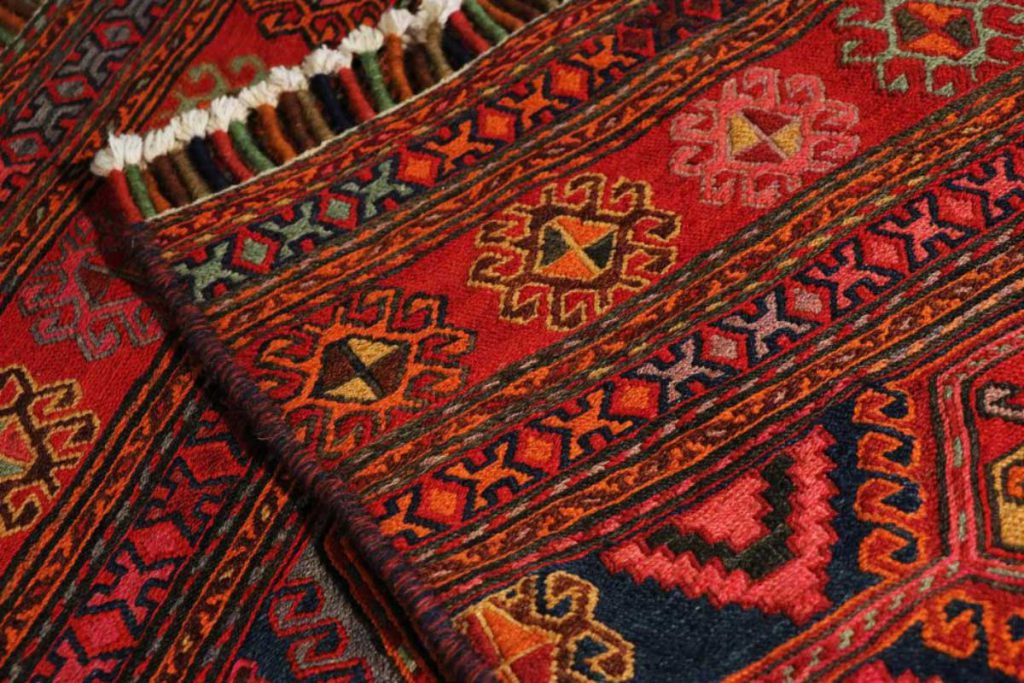
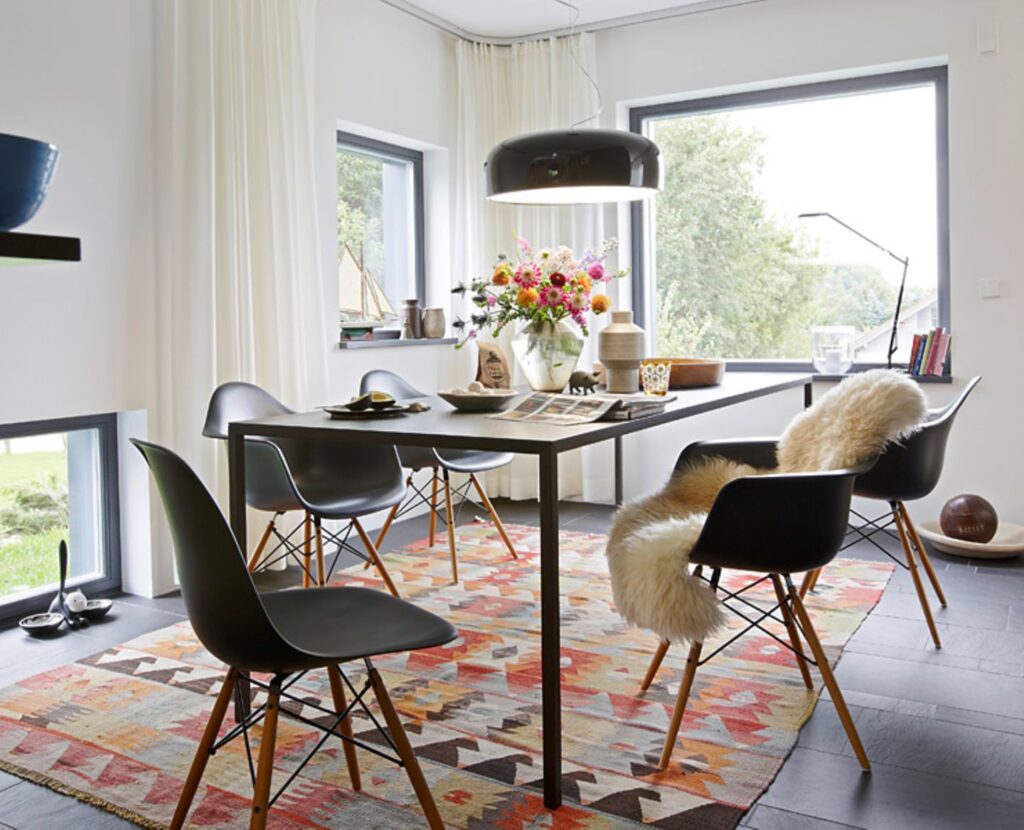
Gabbeh
Gabbeh (from the Persian language farsi; raw, natural, uncut) represents a rough and primitive carpet with patterns mostly made by Ghashghai nomads from the Farsi province in the southwest of Iran. These carpets are probably the most well-known handmade carpets from Iran. They are manufactured by handspun wool, both in the pile and warp, and the yarns are dyed using plant dyes. The carpets are much thicker than other Persian carpets, sometimes up to 2.5 cm thick. The patterns of the carpet are of a simple type with only a few elements of decorative, mostly rectangular objects containing animals. During the last decades, the weavers have had to meet the demands of the west and have therefore, resorted to using large light fields with chary pattering in the Gabbeh carpets.
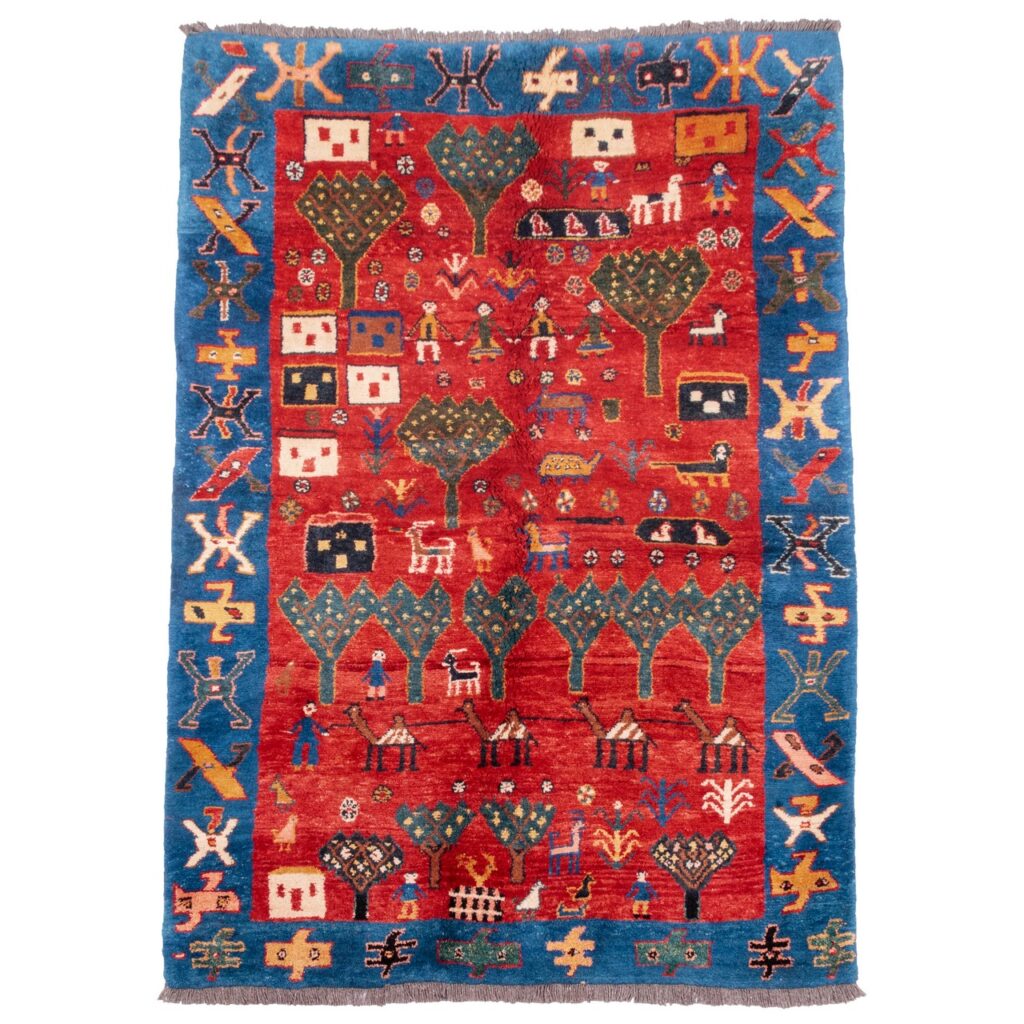
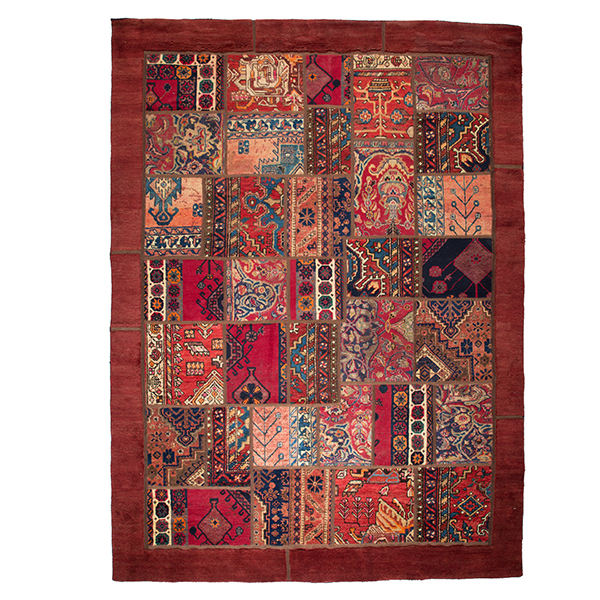
Shisheh gari (Art of blown glass)
Archaeological excavations have shown the spread of blown glass art in the Iran of the Achaemenid era. Glass bottles were found near the Choghal zanbil temple. With the discovery of glass objects dating back to the Parthian and Sassanid periods, it is possible to state that the glass industry was fully flourishing in Iran. Two processing methods were used
The oldest glass object in Iran dates back two thousand years before the birth of Christ. Some finds, ranging from a period ranging from 2000 to 1000 BC, consist of bottles for perfumes, bracelets, bowls and carafes. From the Seljuk era to that of the Mughals, artists from different cities of Iran have distinguished themselves for the production of splendid tableware enriched with various decorations (enameled, carved or with added images).
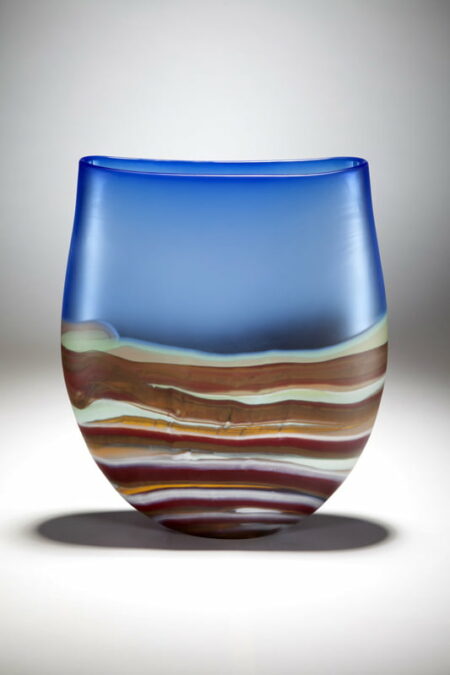
Hasir Bafi
With its several-thousand-year-old history, Hasir Bafi, or mat weaving, is one of the oldest handicrafts. It is not known when and where this craft was first invented. In Khuzestan, Hasir Bafi is common in forms of weaving baskets, mat weaving and Booria Bafi. Generally, there are two kinds of weave: twisted or netted. Today we can find Hasir Bafi in any place of Khuzestan where leaflets, reeds and stems are available. Cities of Abadan, Shadegan, Dasht-e Azadegan are the centers of this product.
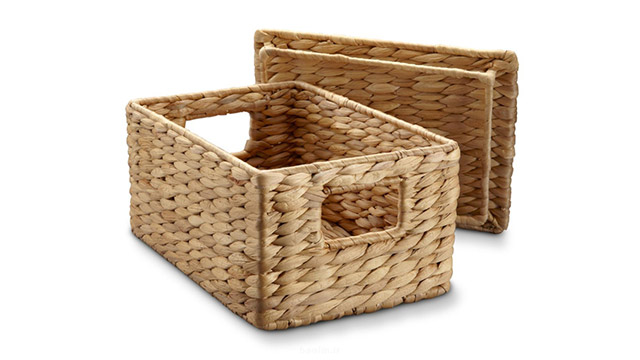
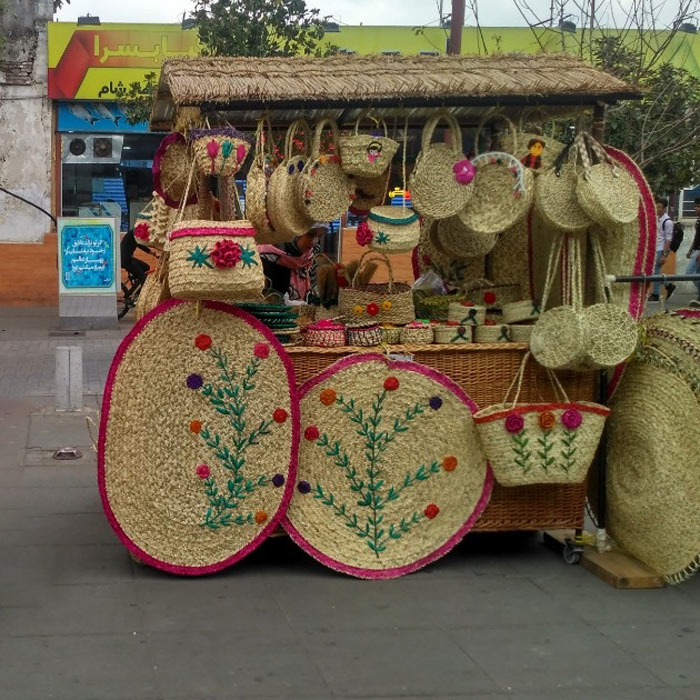
Namadmali
The craft of Namad-mali (literally meaning felt beating) has long been practiced in villages of Semnan province to produce Namad (a traditional carpet) out of woolen fabrics by rolling and pressing them. The method of making felts are almost similar in different areas of Iran, but they sometimes vary in color, pattern, and thickness. Felts are known to be the oldest floor covering that was made by mankind. There is a famous story told by the felt makers of Semnan, narrating that Soleiman the prophet had a son who was a shepherd.
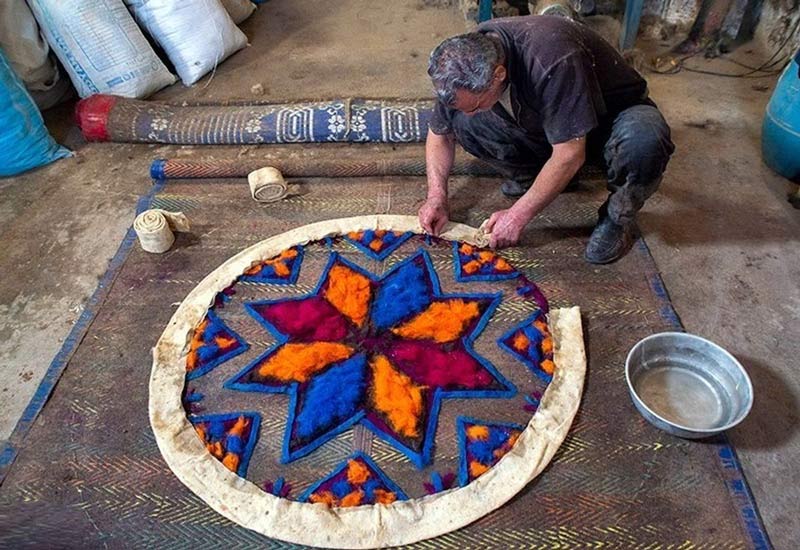
Iran Leather
Iranians with the three-thousand-year history are the first and the oldest producers of leather in the world. The ancient remnants of the BC era indicate that Iranians used skins for clothing, footwear and weapons from about 1500 BC, but since 550 BC, they used leather for clothes and armor. The production of leather products date back to 550 years ago, but Iran’s modern leather industry began at the 1930’s. The first industrial leather plant was established in 1933 in Hamadan and the second plant was founded in 1935 in Tabriz.
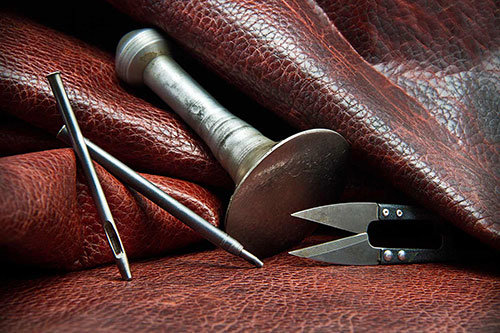
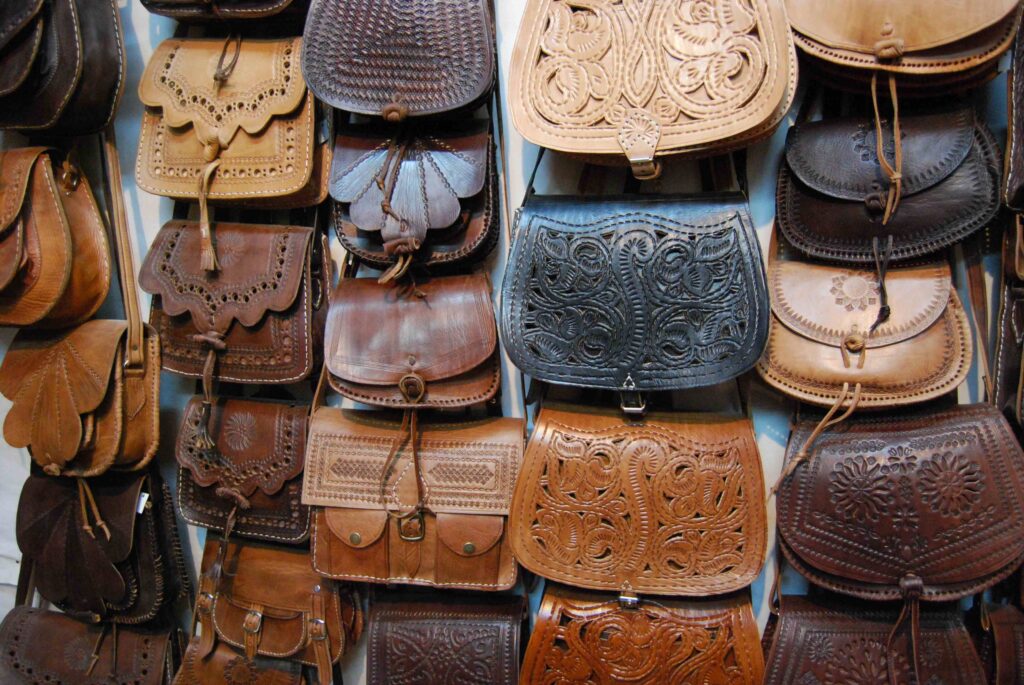
Malileh kari
Malile kari or filigree art is working with gold, silver and copper which are in shape of thin wires. Made in Zanjan, Isfahan, Tabriz
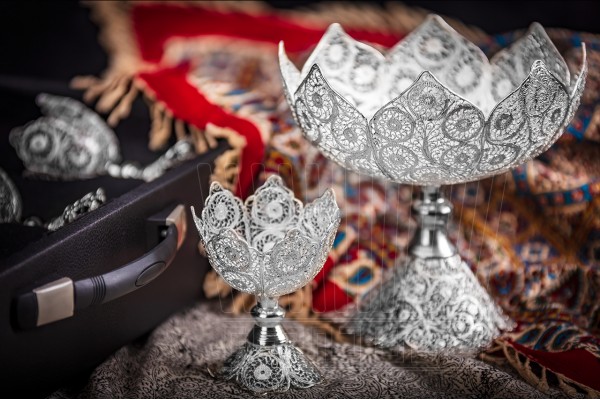
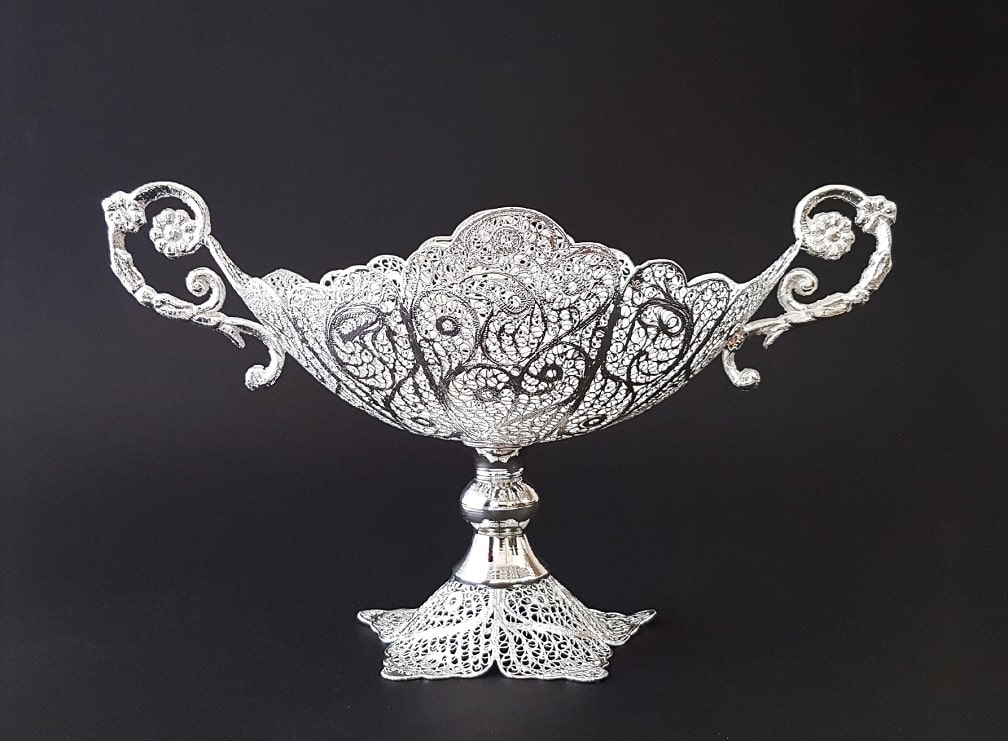
Vitrail
It’s best to know what stained glass is first. Decorating glassware with drawing and painting is an art that has been popular among different nations for centuries, many and varied works of this art can be found in museums around the world. In addition to elegant glassware with professional paintings or intricate and delicate carvings created by master artists in this field from the distant past to the present, sometimes creating designs and even simple colored lines can turn very simple glassware into beautiful and impressive utensils.
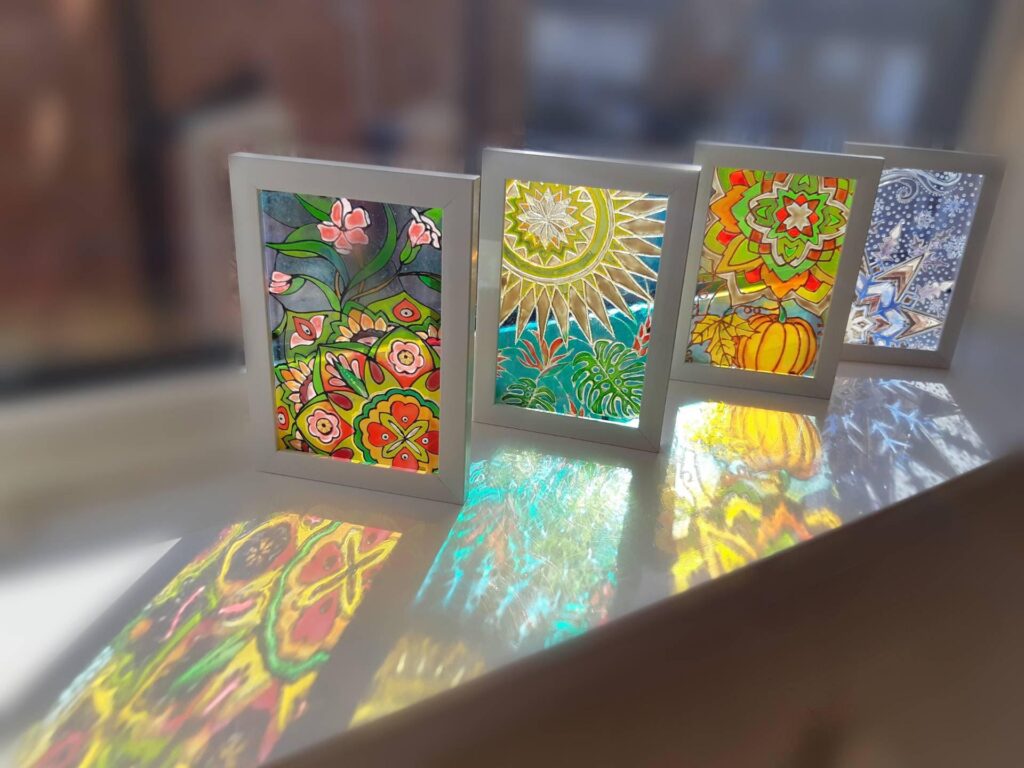
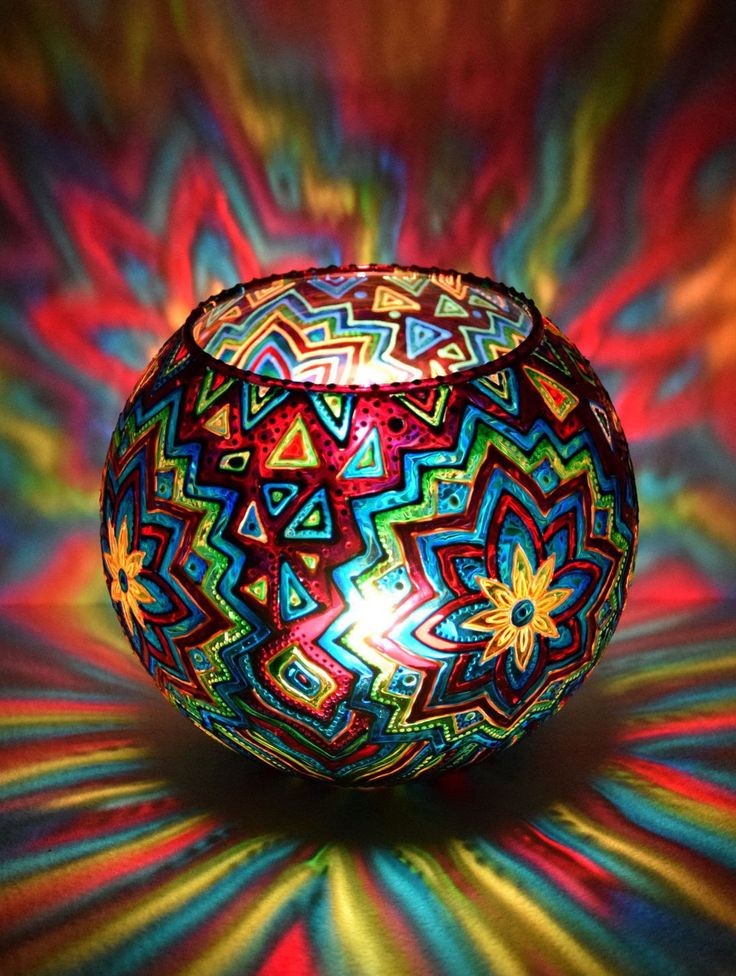
Copper art
One of the oldest technologies in Iran is the technology of producing copper and glassware and shaping with a special design in the past centuries. The first metalworkers, especially coppersmiths, can be considered Iranians, who called the technologists in this field blacksmiths, who, due to their many capabilities such as disinfection in food, high heat tolerance and beautiful shapes, quickly spread this art in countries. The world became different. The coppersmith industry in Isfahan, Kerman, Shiraz, Kashan and Yazd has flourished during the Islamic era and until today, so that in most of these cities, one of the markets called the coppersmith market was dedicated to the owners of this art industry. In the blacksmith market of these cities, dozens of blacksmiths made all kinds of copper utensils, tools and objects with the power of their arms and hammer blows. Today, works of this art can still be found in these markets.
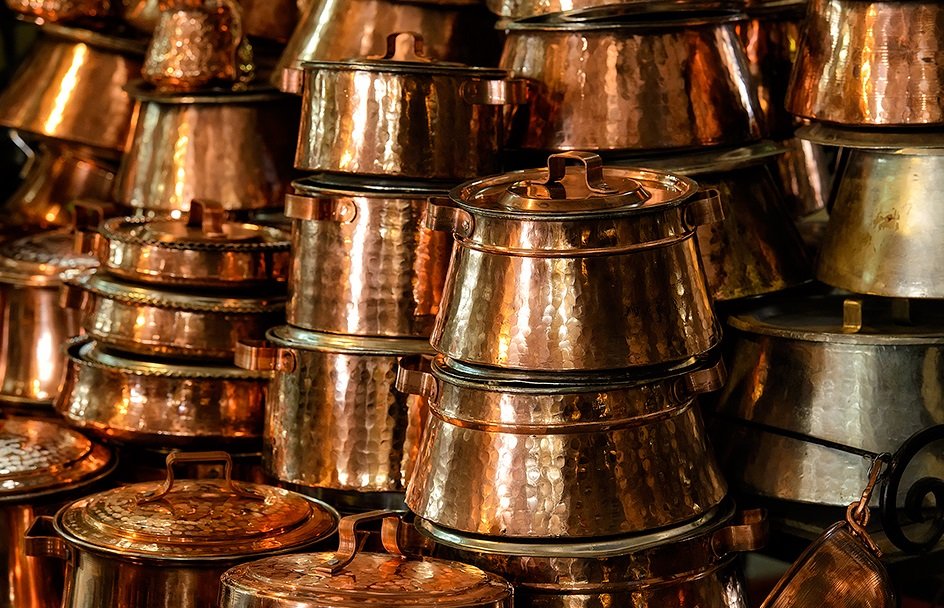
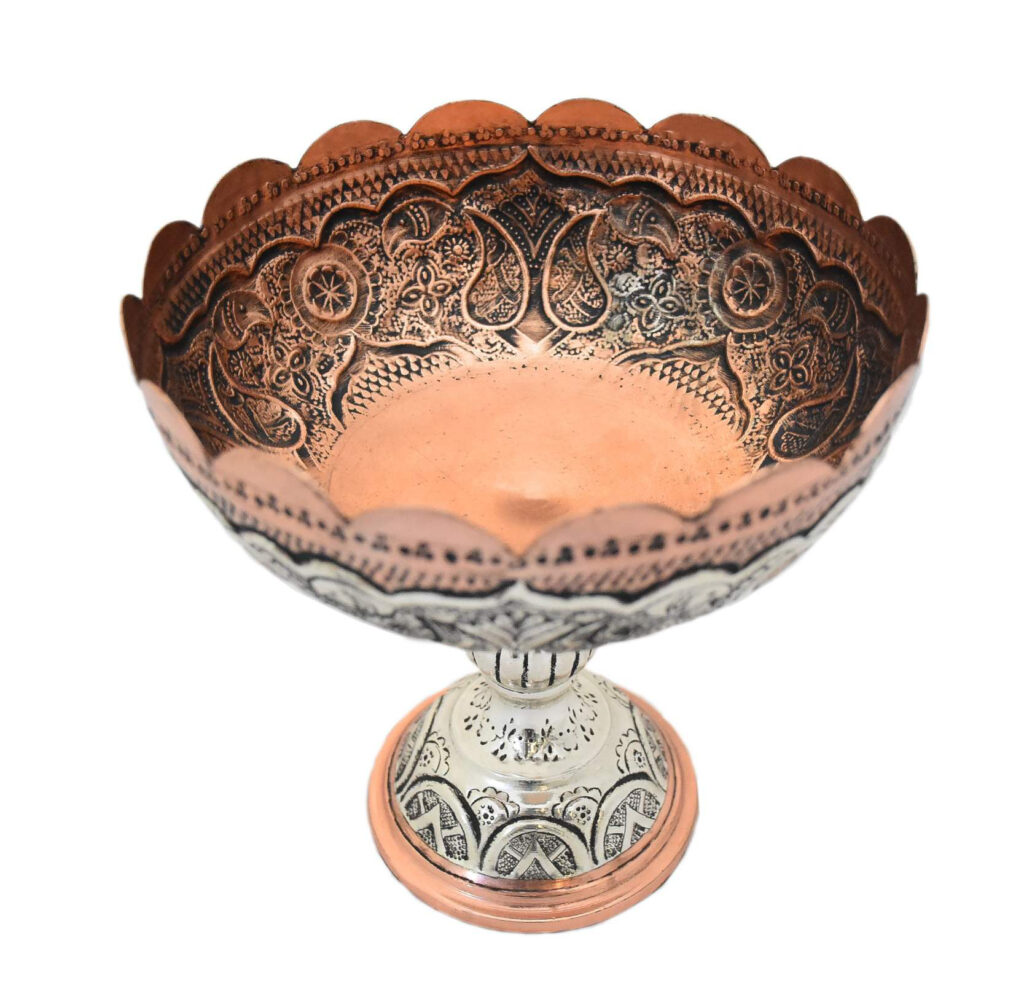
Soozan doozi
This art of embroidery, typical of Baluchestan, a region of Iran located in the south-easternmost part of the country on the border with Pakistan, is used to make the precious traditional clothes that the women of the region still wear with pride. Some women have recently started to make elegant ornaments such as earrings, necklaces, bracelets and more, skilfully embroidering traditional Soozan Doozi designs and creating beautiful combinations
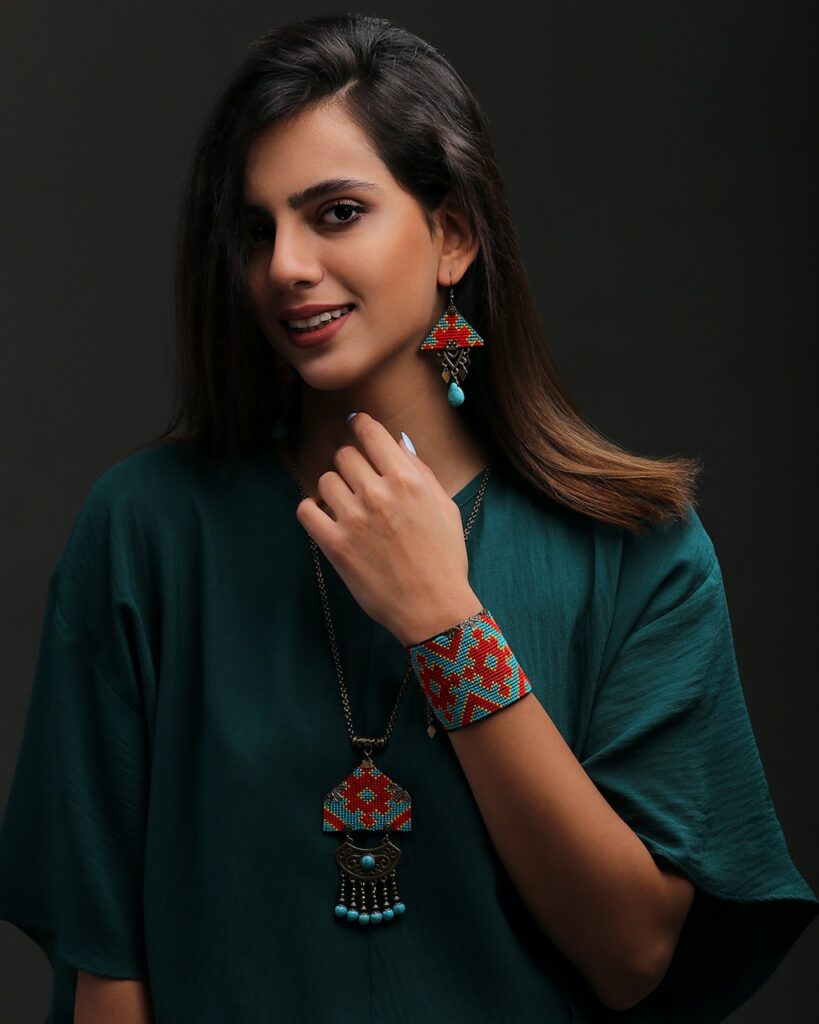
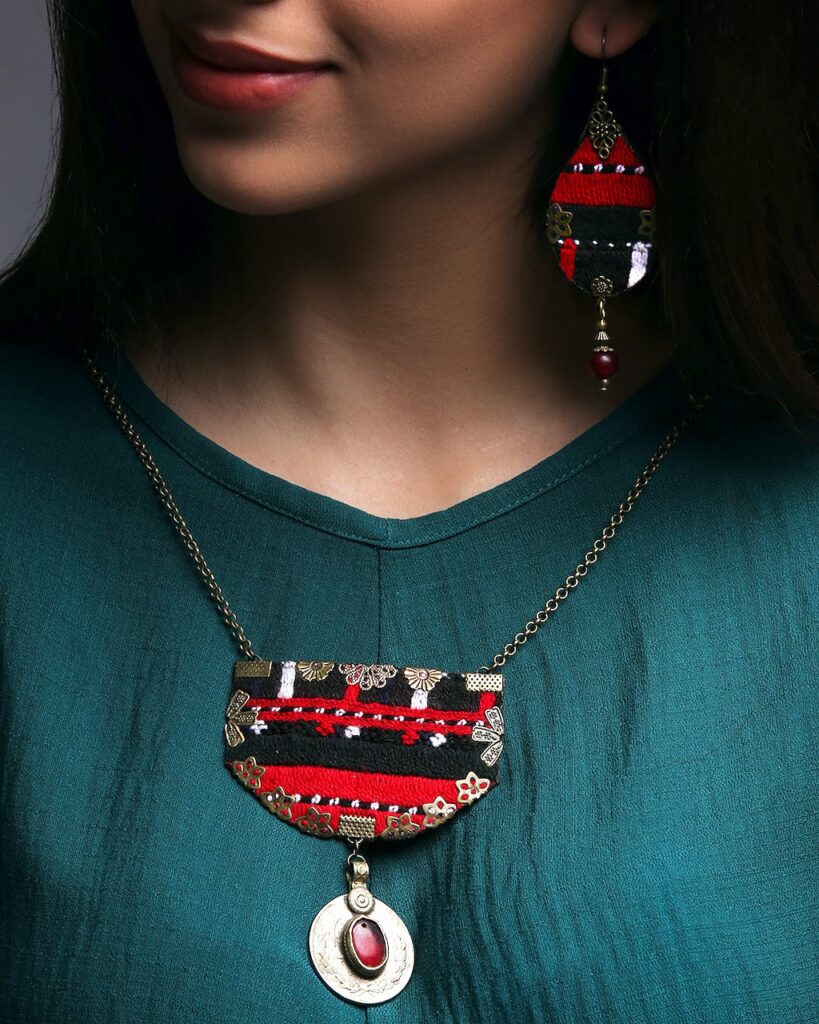
Pateh Doozi
Pateh originated and developed in Kerman province. Although its exact origin is unclear, it is assumed that it was influenced by Kerman rug weaving and thus does not predate the latter. The oldest pateh known is dated to the 18th century.
Many valuable pateh pieces are held in art museums, particularly in Tehran. The oldest and most valuable pateh known is kept in the Astaneh Museum in Mahan, Kerman and dates to 1294 AH (1877 CE). It was created over the course of three years by twelve women. Governor Shahab al-Mulk ordered its creation so that it could be dedicated to the shrine of Shah Nimatullah Wali, a dervish and poet who was born in Kerman.
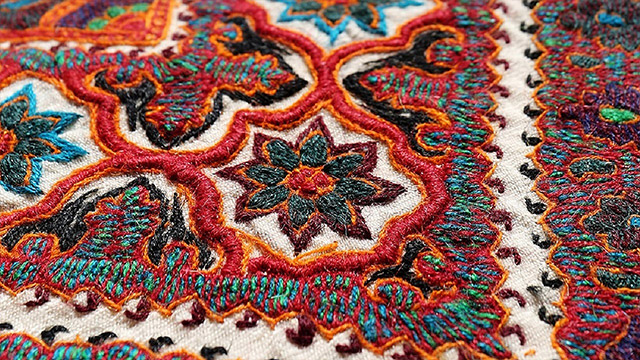
Persian miniature
Persian miniature painting is a courtly and aristocratic art, with exquisite colors, balanced compositions, and meticulous attention to detail. Although its origins can be difficult to trace, many consider the Arzhang, the illustrated book of prophet Mani (founder of Manichaeism and himself also an artist) from the 3rd century CE during the Sassanian Empire as the foundation of Persian schools of painting.
